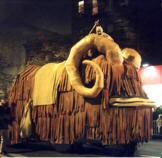Bantha
They are large, quadrupedal mammals with long, thick fur, and are first seen in the film Star Wars (1977), where they are used as beasts of burden by Tusken Raiders on the planet Tatooine.
Art director Leon Erickson led the creation of the bantha costume for Star Wars, the base of which was an elephant saddle with palm fronds and yak hair to create a shaggy coat, as well as a head mask molded from chicken wire, curved horns made from ventilation tubing, and a tail crafted from wood covered with thick thistles.
The banthas in Star Wars were portrayed by a female Asian elephant named Mardji, who was provided by the Marine World Africa USA amusement park.
The creatures have long, furry tails,[6][7] and a pair of spiraling horns extruded from their skulls,[6][7][8] which resemble those of the real-life bighorn sheep,[2][7] as well as the muskox, one of the inspirations behind the bantha.
[9] Star Wars books and media have established biological details about the bantha that go beyond the creature's appearances in the films and television shows.
[13][15] Although often associated with the planet of Tatooine, banthas can be found on many worlds in the Star Wars universe and have adapted to a variety of climates and terrains,[8][13][15] ranging from deserts to tundra.
[16] Marcus Schneck of The Patriot-News has noted the bantha shares similarities to the domestic yak, a bulky, hairy animal used by humans for transportation and food.
[13][14] Despite their gentle temperaments, the size and strength of banthas often lead them to be used as beasts of burden and animals of war, with riders spurring them to charge at foes and trample them.
[51] The game also introduced the Dim-U, a cult-like sect of monks that worship banthas as deities, believing the creatures' far-reaching presence on multiple worlds was a sign of a message from a higher power.
[19][50][52] In the Special Edition version of Return of the Jedi (1983) released in 1997, a shot with a herd of banthas walking through the Tatooine desert was added to the film,[53][54][55] just before the scene in which the sail barge vehicle of the character Jabba the Hutt passes.
[4][54] Star Wars creator George Lucas said he added the shot because it allowed him to expand the environment of the fictional universe and add more nuance to the setting of the film.
[4][57] In the second film, Attack of the Clones (2002), a small herd of banthas are present in another scene set in Mos Espa, next to a docking bay where Anakin Skywalker and Padmé land their ship.
The hovercraft that Jabba the Hutt used to transport the imprisoned Luke Skywalker, Han Solo, and Chewbacca to the Sarlacc monster in Return of the Jedi was called a "Bantha-II cargo skiff".
[79] One alcoholic drink often consumed at the Jabba's palace was called a "Bantha Blaster", and one type of space vessel was named the Bantha-class assault shuttle.
[46] Banthas were created by George Lucas, who was inspired in part by Banths, lion-like carnivorous creatures in the science fantasy serial story John Carter of Mars.
A second version of this draft, dated January 1978, featured a Rebel starfighter pilot with the callsign "Banta One" during the attack on the Death Star.
The original sketches depicted them as horse-like creatures, but with other attributes ultimately used in the final design, including a shaggy coat and two horns around the animal's mouth.
[86] A head mask was molded from chicken wire and sprayed with foam to create the creature's facial features,[4][44][87] and a beard made from horse hair was added.
[4][87] The bantha's curved horns were made from flexible home ventilation tubing,[4][44][87] and its tail was crafted from wood covered with thick thistles.
[4][87] Early plans called for the tail to be carried in the air as the bantha walked, but due to the challenges associated with making this happen, Industrial Light & Magic determined it would be dragged on the ground instead.
[95] The bantha scenes were filmed in mid-January 1977,[4][81][87] in an area of Death Valley known as Desolation Canyon,[97][84][98] which marked the first time Mardji ventured out into the wild.
[85][99][100] Crew members were worried the weight of the head mask would cause Mardji problems;[4][88][89] special make-up effects artist Rick Baker was particularly concerned.
[4][19] Lucas later said he felt a deep connection with Mardji and "fell in love" with the elephant, regularly visiting her at Marine World after filming.
[103] When Lucas revised Star Wars and released a new Special Edition version in 1997, he decided to retain the original shots of the elephant, rather than replacing the bantha with computer-generated imagery.
[104] The bantha costume used in Star Wars was on display at Marine World Africa USA for a time after Mardji's death, but elements of it deteriorated because it was not sufficiently protected, and it was later destroyed.
[105] During the production of Empire, Berg and fellow special effects artists Phil Tippett and Dennis Muren visited Mardji at Marine World Africa USA and shot footage of her walking back and forth for use as a reference in creating the walker's movements.
[4][57] Rick McCallum, a producer with the Special Edition films, said the digital banthas allowed for greater flexibility and freedom of movement than the original version, which he described as "laboriously-made creatures that you couldn't sync up".
[107][108] Additionally, the use of a live elephant for the original bantha inspired the special effects team behind Solo: A Star Wars Story (2018) to use actual dogs to portray Corellian hounds, quadrupedal creatures featured in that film.
[114][115][116] Originally entitled simply Official Star Wars Fan Club when first published in 1978, the newsletter was renamed after a contest in the second issue invited readers to submit new names.
"[120] A September 18, 2014 episode of the educational children's television series Sesame Street featured a Star Wars-inspired segment in which Mr. Snuffleupagus, a woolly mammoth-like Muppet character, appeared as a bantha.


